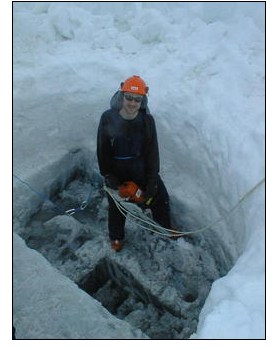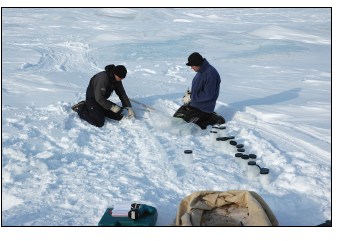|
|
Bio-geochemical sampling
The bio-geochemical programme will identify and compare the pathways of biological and biochemical
cycling and transformations in sea ice, water column and sediments and identify sources, sinks and
transport processes associated with biological and biogeochemical fluxes. The work will be based on
coring at the ice camp and other sites visited in connection with helicopter flights for other activities.
Analysis issues are dissolved inorganic carbon (DIC), carbon dioxide (CO2) and alkalinity (TA).
 High-latitude oceans act as a sink for atmospheric CO2 and thereby represent a direct pathway for the
CO2 -exchange between the atmosphere and the deep ocean (Takahashi et al. 2002). The difference between
pCO2 in the surface water and the overlying air represents the thermodynamic driving potential for
air-sea CO2-gas exchange which influences the surface concentrations of DIC. Surface water pCO2-levels
are regulated by temperature, salinity and DIC and TA concentrations. DIC and TA have hitherto been
considered to be controlled by biological processes, e.g. photosynthesis, respiration and calcification,
and by up-welling of surface water enriched in respired CO2 and nutrients and air-sea exchange. High-latitude oceans act as a sink for atmospheric CO2 and thereby represent a direct pathway for the
CO2 -exchange between the atmosphere and the deep ocean (Takahashi et al. 2002). The difference between
pCO2 in the surface water and the overlying air represents the thermodynamic driving potential for
air-sea CO2-gas exchange which influences the surface concentrations of DIC. Surface water pCO2-levels
are regulated by temperature, salinity and DIC and TA concentrations. DIC and TA have hitherto been
considered to be controlled by biological processes, e.g. photosynthesis, respiration and calcification,
and by up-welling of surface water enriched in respired CO2 and nutrients and air-sea exchange.
However, our recent findings suggest that besides oxygen DIC is also rejected from growing sea ice
together with brine (Glud et al. 2002, Rysgaard et al. 2007).  In addition, we have observed very low
DIC and TA concentrations in Arctic first-year sea ice as well as fractionation of DIC and TA compared
to the surface-water conditions. Downward rejection of CO2 from growing sea ice together with brine
has not been considered previously, nor has the atmosphere-ice-ocean exchange of carbon caused by the
sea-ice driven DIC pump been quantified. Our initial model calculations show that this DIC pump affects
the surface pCO2 significantly in polar seas and potentially sequesters large amounts of CO2 in the deep
ocean. Brine-mediated DIC transport into the deep ocean may be significant in the global carbon cycle and
variations in sea ice formation under past climate conditions might help explaining variations in
atmospheric CO2 levels. Likewise, a future decrease of the global sea ice cover may reduce the world
ocean's capacity for taking up atmospheric CO2. The work to be undertaken is directed towards this issue.
In addition, we have observed very low
DIC and TA concentrations in Arctic first-year sea ice as well as fractionation of DIC and TA compared
to the surface-water conditions. Downward rejection of CO2 from growing sea ice together with brine
has not been considered previously, nor has the atmosphere-ice-ocean exchange of carbon caused by the
sea-ice driven DIC pump been quantified. Our initial model calculations show that this DIC pump affects
the surface pCO2 significantly in polar seas and potentially sequesters large amounts of CO2 in the deep
ocean. Brine-mediated DIC transport into the deep ocean may be significant in the global carbon cycle and
variations in sea ice formation under past climate conditions might help explaining variations in
atmospheric CO2 levels. Likewise, a future decrease of the global sea ice cover may reduce the world
ocean's capacity for taking up atmospheric CO2. The work to be undertaken is directed towards this issue.
|

